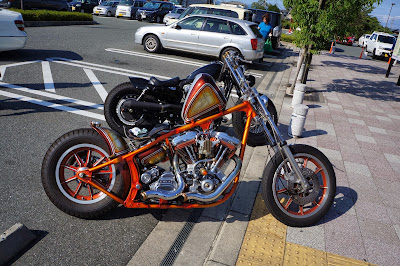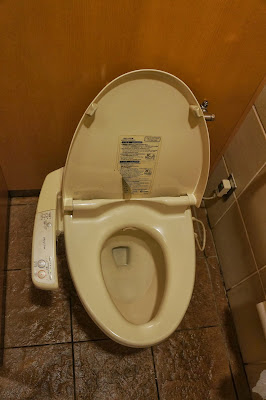Two hours time difference with Vladivostok, but about the same
distance from Greenwich : it was dark at 6 instead of 8 in the evening . We stopped at 17:00 to
make camp on a deserted beach near Daiei and got stuck as soon as we
drove from the vegetation on to the sand. For the colleagues :
d50 of about 400µ in a steep curve and semi rounded grain = not very
surprising.
 |
| Yep, 400µ! |
With the central and the aft lock : only vertical
progress. Tires deflated to 1,20 bar and a little digging helped us
out in sec's.
Remark : last time I checked the tire pressure
was in the snow in Susuman on the Kolyma with – 3°C. The temperature in Daiei
was +27°C. The 30°C difference made the pressure rise with about
0,5 bar. This is not an excuse but a fact.
 |
| 6 in the morning on the deserted beach near Daiei. |
The
time difference with Vladivostok did not change our habits. In the
morning we were on our feet at 6 instead of 8 and started to make
camp around 18 instead of 20. No ferry-lag.
Traffic
in Japan is at about 50 km/h. The advantage : the scenery in the
mountains is surprising and there is a lot to see.
 |
Sakaiminato port (A) - Daiei (B) - Kyotamba (C) - Makino (D) -
Eihei-Ji Monastery (E) - Izumi (F) - Shirakawago Historical Villages (G) -
(Taira) Gokayama Historical Village (H) - In the mountains on the 471 (I). |
We
thought that it was better to go to the north while the weather was
still splendid and drove up the number 9 towards Kyoto. With the
prolonged weekend : Kyoto was hell. Everybody possessing a set
of wheels was on the road towards the lake Biwako and therefore we
decided that we would do Kyoto on our way back from the north.
 |
| Just somewhere along the 9 towards Kyoto. |
We
camped at the Biwako lake for 5600 Yen plus 200 Yen each for a 3 minutes hot
shower ! 6.000 Yen for one night on a camping : this was my
first and my last (Barry White?).
 |
| Camping at Biwako, the biggest Japanese sweet water lake. |
Around
17:00/18:00 the shops are closing. Immediately after the
villages/small towns become ghost towns. Not a soul in the streets.
In Izumi we prepared our dinner on the deserted central square with a
hungry cat as sole companion. Only here and there a small light
behind a door or a window. In the morning at 6, speakers in the
centre announce a new day with sometimes a little song. The wake up
call for the whole town ? This is repeated at noon and in the
evening at 18:00. Or is it a Buddha thing ?
 |
| With the long weekend, everybody was on the move. |
 |
| Also the lady with the 1200 Sportster. |
 |
| H.D.'s |
Eiheiji
Monastery: established in 1244 by the great Zen master Dogen, founder
of the Soto sect of Zen Buddhism. About 150 priests and disciples
are residing in the monastery. We met two of them while they were
jogging around the Eiheiji lake, formed by the dam. Next day we saw
both again in the monastery performing various duties.
One
monk was practising the art (it looked more like a dance) of bringing
a book to the priest during the ceremony.
Parts
of the monastery are rebuilt in the 18th and 19th
century. Today these constructions look like new. Maintenance. Not in
the Mongolian dictionary?
 |
| Part of the vast Eihei-ji Monastery. |
 |
| Monk. |
A typhoon was riding the east coast and it was pouring non stop for about 24 hours. The temperature dropped from 27°C to 17°C.
These villages were founded in the remote mountains by the surviving members of the Taira clan, butchered by the Minamoto clan in 1185. The different villages have about the same gasshö-zukuri architecture, but there are small differences in for example : the angle of the roof or the way the top of the roof has been finished. The people survived by cultivating the silk worm that seems to go hand in hand with the fabrication of gunpowder. They produced also paper and today you can attend workshops, … very Zen.
 |
| Roof construction. |
We
camped off the road near a building in the centre of Taira and next
morning we were invited in for tea, by the teachers of the nursery
school. The kids made for us some small origami euh … pieces/items
... Sweet.
 |
|
Down
the narrow 471 to Takayama. Very scenic and sometimes scary. We
backed up several times to let the locals go by and slept in a very
small mountain village next to the enormous town hall with
possibilities to BBQ in the park, walk along a small man made river or sit on a small hill with a pergola. The village was dead
now, but probably during the summer, a lot of activities were
on-going
 |
| Road 471. |
 |
| Nice huh? On the bottom of the valley a town. |
 |
Matsumoto (B) - Nikko (D) - Aizuwakamatsu (F) - Matsushima (H) -
Camping at the coast on 26/10, experiencing an earthquake and a tsunami (I). |
Matsumoto :
castle from the Ogasawara clan in the 14
th and 15
th
century and saved from demolition by two men living in Matsumoto in
the 19
th century. One bought the castle back from the
government that had planned to build apartment blocks on the spot.
Now Matsumoto is one of four castles designated National Treasure.
 |
1543, introduction of European fire arms.
"The Last Samurai" with Cruise: utter bull? |
Nikko :
the glories of the Edo period (1600 – 1868) with the wooden
Imperial Villa (106 rooms and 450 m of visitors corridors) where the
emperor Hirohito spent WWII and in between giant cedars the shrines
and temples of Tosho-gu.
 |
| Kegon Falls: probably there or just loud speakers? |
 |
| Imperial Villa. During WWII, emperor Hirohito lived in the villa. |
 |
| Empress with the kids. |
We
stopped at a supermarket in Imaichi and bought sushi, crab, salad and white
Japanese wine for dinner. Life can be a bitch. For the Frenchies :
also the Japanese white wine is delicious.
 |
| Tosho-gu. |
Japan
is one civilized country! Public toilets are not only clean, but the seats are
heated and the bowl equipped with a spray system. You can also adjust the
pressure of the spray system ! With the pressure on max and a
little wiggle-waggle you obtain the maximum result. ^_^ Hai!
 |
| Newly wed and flanked by samurai. |
 |
Reconstructed castle (concrete!) with exhibitions about the
traditional live during the Edo period.
Please, no pictures from the displayed war lord helmets. |
On
our next stop on one of the info-parking's just north of Kitakata (no, I'm
not making this up), we went to the hot water baths. For the
equivalent of 3 € p.p., we showered, shampooed, soaked our old
bones in the hot water pool until we were « cooked lobster »
coloured and went to the sauna. All
completely naked, but men and women separated … bummer.
From
Aizuwakamatsu we drove over the scenic 121 and the busy 13 & 48,
on the 100 km perimeter with Fukushima N° 1, north, towards
Matsushima. Matsushima was too crowded to our taste and also due to
the drivelling weather we left the charming place after a picture of
the bay and a visit to the Zen monastery 828 A.D.
 |
| Old tree under treatment after the Tsunami of March 2011. |
The
Japanese wouldn't be Japanese if they did not announce the start and
end of each area influenced by the Tsunami along the coast. Driving in
Japan is easy without GPS. Each road has a number and these numbers
are indicated on the road signs and along the road. Driving through a
city or looking for a castle in a city is easy. Every point of
interest, no matter how insignificant, is indicated. Also the
Tsunami disaster areas.
 |
| Matsushima, ... but museum closed. |
 |
On special request of Christine.
Notice the design ladybird.
|

















































Camping on the beach, nice!
ReplyDeleteYep!
ReplyDeleteWiggle that ass!
ReplyDeleteAlso: in the computer game Shogun: Total War, the Dutch and Portugese come to Japan somewhere in the 16th century to trade and they bring firearms with them.
Christine, Filiep,
ReplyDeletevia Kaat de link naar jullie blog gekregen. Dit verlengd weekend, bij nat en druilerige donkerte verdiep ik mij eens in jullie reisverhaal ! Zie er alvast naar uit jullie reisescapades te lezen...
Veel succes daar verre weg !
Beste Christine en Filiep,
ReplyDeleteProficiat met jullie blog. Filiep maakt er zijn werk van!
Uit de reisverhalen en foto's op te maken is het een avontuurlijke, afwisselende en prachtige reis. Goede reis verder en vele groetjes uit Stekene van Dirk en Margot en de jongens.
Merci Margot & Dirk.
Delete